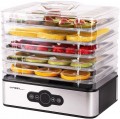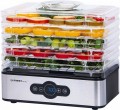The size of one tray of the dryer in height. In models where, instead of separate trays, a common working chamber with removable shelves is provided, the distance between two adjacent shelves is indicated.
This size primarily determines the thickness of individual pieces of vegetables, fruits, etc., which can be placed in the device. At the same time, note that the contents should not fill the tray tightly — there should be at least a couple of millimetres of space between the products and the “ceiling”. Also note that in some models, two height values can be indicated in this paragraph — for example, “15 — 25 mm”. This means that the size of the trays can be changed, adjusting them to the specifics of the situation; usually it is a choice between two standard heights (in our example — 15 mm and 25 mm).
The material from which the complete trays of the dryer are made.
—
Plastic. Inexpensive, but at the same time very practical material. In terms of strength and overall reliability, the plastic is inferior to metal, however, during normal use of the dryer, this difference is not noticeable. In addition, if such trays are made in the form of complete compartments, their walls can be made transparent so that you can observe the contents without interrupting the process and without knocking down the temperature regime. However the transparent walls gradually become cloudy due to the low resistance of plastic to scratches — however, it takes a lot of time for this moment to become a serious inconvenience. Thus, most modern dryers use plastic trays.
—
Stainless steel. The main advantages of metal trays are strength and resistance to overheating. On the other hand, these advantages rarely turn out to be significant, and steel is more expensive than plastic. In addition, if metal trays are made in the form of separate compartments, they are opaque, and to check the condition of the products, you will have to open these compartments, lowering the temperature and disrupting the process. . For models with a rear fan (see above), this point is not relevant — they usually have a transparent door; however, such devices are not cheap. Thus, this tray material is rare nowadays — mainly among advanced dryers.

